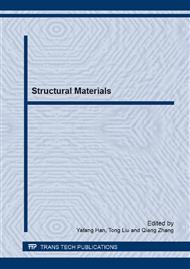[1]
Min You, Lu Lu Zhang, Zheng Peng Gong, et al, On the Properties of Conductive Adhesive Filled with Electroless Silver Plated Flake Graphite, Key Engineering Materials. 373(2008) 220-223
DOI: 10.4028/www.scientific.net/kem.373-374.220
Google Scholar
[2]
Y.C Chan, D.Y Luk, Effects of bonding parameters on the reliability performance of anisotropic conductive adhesive interconnects for flip-chip-on-flex packages assembly II. Different bonding pressure, Microelectronics Reliability, 51(2006), 1195-1204
DOI: 10.1016/s0026-2714(02)00089-6
Google Scholar
[3]
Giulio Malucelli, Aldo Priola, Polyurethane resin-based adhesives: curing reaction and properties of cured systems, International Journal of Adhesion and Adhesives. 25(2005), 87-91
DOI: 10.1016/j.ijadhadh.2004.04.003
Google Scholar
[4]
Irfan Mir, D. Kumar, Recent advances in isotropic conductive adhesives for electronics packaging applications, International Journal of Adhesion and Adhesives. 18(1995), 362-371
DOI: 10.1016/j.ijadhadh.2007.10.004
Google Scholar
[5]
Jong Min Kim, K.C. Yang, et al, Effect of Post Weld Heat Treatment on the Interface Microstructure of Explosively Welded Titanium/Stainless Steel Composite Clad, Materials Science Forum. 580(2008), 29-32
DOI: 10.4028/www.scientific.net/msf.580-582.29
Google Scholar
[6]
Jagt, J.C, Reliability of electrically conductive adhesive joints for surface mount applications: a summary of the state of the art, Packaging, and Manufacturing Technology. 26(2005), 215-225
DOI: 10.1109/95.705467
Google Scholar
[7]
Rui Ming Yin et al, Finite-Time Stabilization for Singular Linear Time-Delay Systems with Time-Varying Exogenous Disturbance, Advanced Materials Research. 490(2012), 2459-2463
DOI: 10.4028/www.scientific.net/amr.490-495.2459
Google Scholar
[8]
Shu Quan Liang, Yan Tang, et al, Negative Synergism between Corrosion and Wear of Nickel-Free Austenitic Stainless Steel in Artificial Body Solution, Materials Science Forum. 610(2009), 1183-1187
DOI: 10.4028/www.scientific.net/msf.610-613.1183
Google Scholar
[9]
Yong De Hao et al, Crystal, Electronic and Magnetic Structure of Co and Ag Doped Rutile TiO2 from First-Principles Calculations, Advanced Materials Research. 399(2011), 1789-1792
DOI: 10.4028/www.scientific.net/amr.399-401.1789
Google Scholar


